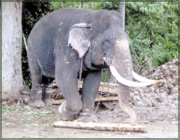|
DAILY NEWS ONLINE |
|
|
|
OTHER EDITIONS |
|
|
|
|
|
|
|
|
|
OTHER LINKS |
|
|
|
|
|
|
 |
Pinnawela Elephant Centre is thirty yearsPINNAWELA Elephant Centre, established in February 1975 by the Wildlife Conservation Department, was taken over by the National Zoological Gardens at Dehiwela in 1938.
It started as an orphanage for elephant calves found in the wilds, bereft of their mothers who most usually lost their lives in the ongoing conflict between man and beast. The Centre later developed into a safe haven for adult wild elephants too who required human assistance. At the inception there were only five orphaned calves. But now thirty years later there is a total of 70 elephants brought in from the wilds, varying in age from a four-month old calf to a 64-year-old tusker blind in both eyes. The tusker's keeper told me that the day he was brought to Pinnawela by the staff of the Wildlife Conservation Department, he was fighting mad - the most difficult beast that they ever had to restrain and control. In his new home this blind tusker is at least in peace and docile as ever. There is also a female elephant named Sama - an unfortunate victim of the recent civil war in the North and East, who had part of a front foot blown off by a land mine. This foot is about six inches shorter than the others, but it does not stop her from mingling and getting about with the rest of the herd. Present herdThe present captive herd at Pinnawela is comprised 27 males and 43 females, confined to a 25 acre cleared old coconut block of land. There are 28 mahouts to look after them. The fact that the herd is allowed unfettered movement during the day is the primary attraction specially at bath time when they are allowed to frolic in the nearby Maha-oya.
The flat rocky bottom of the river provides a large number of shallow pools, allowing the animals to splash and lie down to be scrubbed by their keepers. Some of them scamper across the shallow river to the other side to scrape the mud off the high bank and cover themselves with mud. The other attraction is bottle-feeding the calves. Each one gets seven giant-sized bottles of milk plus five other meals a day. River bathing takes place twice daily between 10 a.m. and 12 noon and 2 p.m. and 4 p.m. Bottle feeding may be seen at 9.15 a.m., 1.15 p.m. and again after 4 p.m. Adult animals are tethered for the night in their stalls between 4.30p.m. and 6 p.m. at which time they are given their evening feed of coconut, kitul, tamarind, jak leaves, some logs, plus a mixture of maize, rice bran, powdered gingelly seed and minerals. Captive breedingEntertainment however is not the only purpose of this elephant centre. Captive breeding is an important objective. Birth of elephants in captivity in Sri Lanka has been rare. Partly due to a lack of a herd instinct, and other practical difficulties such as the inability to coordinate the breeding activities of work elephants, and the loss of revenue when females become pregnant. The pregnancy period is over 20 months. The first calf in this captive breeding scheme was born on July 5, 1984. She was a female named Sukumalee. Her mother was Kumari and her father Vijaya, 20 and 21 years old respectively. Although females were seen to reach sexual maturity between 10 and 12 years, and males between 12 and 15, the practice of mating was observed to be most successful between 20 and 25 years. Between 1984 and 1997 there were 12 more births. The calves were born to seven females. Two males sired 80 per cent of the births. This identification was made possible by DNA testing. The two males involved were Vijaya and Neela who sired seven and five respectively. Vijaya and Kumari produced three calves at intervals of 4 and 5 years respectively, a calving interval that is normal for Asia. The birth weight of Kumari's third calf was a healthy 86 kg. the oldest female to calve at Pinnawala was 45 years. She calved again when 54 years. The youngest female to calve at Pinnawala was Sukumalee, the first baby to be born there in 1984. She gave birth to a calf on February 7, 1997 starting a second generation of births in captivity. The breeding program at Pinnawala has demonstrated that it is practically possible to maintain and increase the population of elephants in captivity within the social structure of a small herd, contributing to a more viable genetic diversity at the same time. Future developmentThe aim now is to increase the number of elephants at Pinnawala to one hundred on the same 25 acre block. The authorities do not consider it necessary to extend the land area, since the elephants are stall-fed, adopting a system of cut and carry as for farm animals. Further improvements however are expected for the benefit of both elephants and visitors. These include a waterhole for bathing within the premises, open feeding area, mini-laboratory, X-ray unit and restraining facilities for elephants. An up-to-date visitors' complex is also envisaged with baggage and security rooms, coffee shop, souvenir shop, information unit and video facilities to provide a clearer understanding of the need for elephant conservation and management. |
||
|
|
|
|||
|
|
|||






